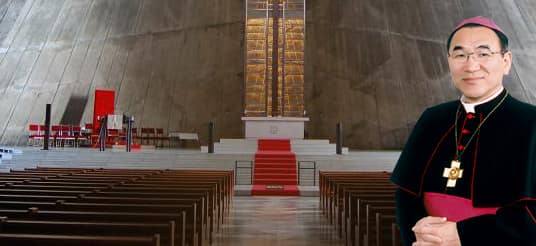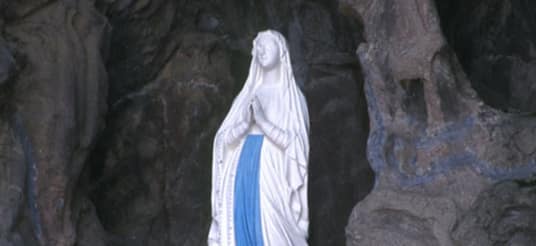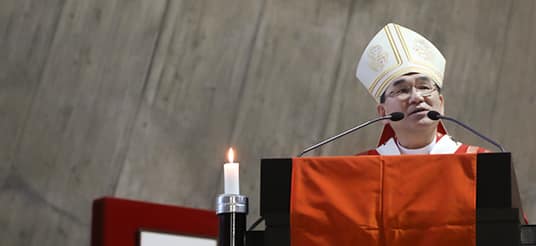Archdiocese of Tokyo

To Welcome 2009 with all the faithful of the Tokyo Archdiocese
Greeting for the New Year’s assembly
February 8, 2009 (Sunday)
St.Mary’s Cathedral, Tokyo
1. On November 24 last year, the Catholic Church of Japan received a great blessing with the Beatification of Peter Kibe and 187 other martyrs, held in Nagasaki.
Among these 188 martyrs were two who were martyred in our own archdiocese, Peter Kibe and John Haramondo. It is my eager desire that all the faithful of the archdiocese may learn from the faith of all 188 martyrs and in particular from the faith and lives of these two Tokyo martyrs.
The memorial day of the martyrs is July 1. On that day a Mass for “Peter Kibe and the 187 Companion Martyrs” should be celebrated in every Church. I ask that prayers for the intercession of Peter Kibe and the 187 martyrs should be offered also on Sunday July 5.
2. Included among the 188 Blessed are four martyr priests. These are Julian Nakaura, Diogo Yuuki Ryosetsu, Thomas Kintsuba Jihyoe and Peter Kibe Kasui. These four faithfully lived out their duties as Catholic priests and, as good pastors, finally laid down their lives for their sheep.
According to the 34th chapter of the Prophet Ezekiel, a good pastor is a pastor that feeds his sheep and not himself. How do we bishops and priests fulfill our duties today? Are we faithfully carrying out our responsibility to strengthen the weak, heal the sick, and comfort the suffering? Recently we have heard about problems of sexual harassment and power harassment by Catholic priests. We bishops and priests must sincerely reflect on this point.
3. There were 60 women among the 188 martyrs. I myself was especially impressed by Ms Miya Ogasawara. She was the wife of Genya Ogasawara and mother of 9 children. There were also four employees in the Ogasawara family.
All 15 of these were martyred in Kumamoto on January 30, 1636. Here we can see the firm unity that bound this large family together in faith, hope and love. Today, 400 years later, our homes and our families are in an extremely critical situation.
4. The second National Incentive Convention for Evangelization (NICE-2) held in 1993 chose the “Family” as its theme. The Bishops’ Conference, acting upon the report from NICE-2, emphasized that the Church must support and give guidance to the family, the basic unit of human society.
The rebuilding and reform of Japanese society must first of all begin from the renewal and restructuring of relationships between man and woman, husband and wife, parents and children, brothers and sisters. In his sermon at the Mass of Beatification Cardinal Seiichi Shirayanagi encouraged us all to imitate these martyrs of 400 years ago, who were so solicitous for their homes and families.
5. Do you know the “Prayer for the Tokyo Cathedral and the Archdiocese?” In this prayer we ask, “Dear Lord, please give to us of the Tokyo Archdiocese the grace to heal, enliven and encourage, to offer hope and companionship to the many people who are troubled and suffer in the wilderness of this present age.”
Words such as “wilderness” were also used in the sermon for the Mass of Pope Benedict XVI’s inauguration ceremony. I clearly feel that we faithful of the Tokyo Archdiocese find ourselves in a wilderness or desert. Therefore I fervently desire that our church may become a spring, an oasis in this wilderness.
With this in mind I have set three priority issues for the archdiocese. They are
(1) The spiritual growth of all believers engaged in the Church’s mission of evangelization.
(2) The growth of the archdiocese as a multi-national church of mutual support.
(3) Companionship with people who suffer from deep psychological problems.
I first called attention to these priority issues back in 2002. We are still at a stage of trial and error regarding concrete implementation. However, when I look around at the various activities taking place in the archdiocese, I am optimistic and feel that these priorities have been understood and are gradually seeping in. So today once again I ask you all, in your mission districts, your parish communities, your religious houses, and various other groups, to look anew at the priority issues and give them serious consideration.
6. I want to talk first about the first priority, “the spiritual growth of all believers engaged in the Church’s mission of evangelization.”
Recently various methods of Bible sharing have become widespread. These are useful for our spiritual growth and I recommend them so that more and more people may participate in them.
In addition, until the feast of Saint Paul on June 29 of this year we are observing a Pauline Year. This is a good occasion for recommending greater familiarity with the teaching of Saint Paul.
One theme that I want to emphasize this year is “the role of Catholic priests and lay people, their relationships and cooperation.” In 2003 I proposed some “Guidelines for the Catholic mission districts of the Tokyo Archdiocese” at the time these districts were initiated. Six years have passed and I ask you to read these Guidelines once again and make an effort to continue building better relations between priests and lay people.
7. Next is “the growth of the Tokyo Archdiocese as a multi-national church of mutual support.”
The Archdiocese of Tokyo through the Catholic Tokyo International Center (CTIC) has been offering counsel, support and pastoral care for immigrants, refugees and transient citizens of foreign countries who find themselves in difficult situations. Next year, 2010, will be the 20th anniversary of the inauguration of CTIC. Offices that were formerly located in three different places (Kameido, Meguro and Chiba) have been integrated and the new CTIC office has been opened at Meguro church.
Mutual support is not a problem only for CTIC. It is a task that all parish communities should perform, and I hope for stronger connections between CTIC and the parishes.
8. Finally, there is “companionship with people who suffer from deep psychological problems.”
For 2000 years the Church has always supported people with psychological problems or psychic wounds in order to help them, heal them, or provide spiritual support. Jesus was truly a person of great healing power. The reason why we must take up this problem as a special priority issue is that we can see it clearly as “a sign of the times.” Many people suffer from excessively acute stress, bear deep psychological wounds, have lost their way and are deeply troubled. The church itself must become a spring and an oasis for them in their wilderness.
People need healing and support. I think we can do much by conversing with God through prayer and the liturgy, or through contact with people who have a compassionate and welcoming heart. The small things of daily life can be turned into great opportunities for mutual support.
In addition, the Tokyo Archdiocese has a “Tokyo House of Charity” foundation, which has been coping with these psychological sufferings and has inaugurated a consultation room for family welfare. I consider this work to be an exemplary reply to the third priority of the archdiocese and I hope and pray that it may be blessed with further development and substantial growth.
This year I expect much from the plans and work of the archdiocesan welfare committee. In addition, a series of lectures about this problem is being planned by the priest in charge.
9. As a final point, I want to say something about the restructuring of the Cathedral compounds and the construction of a residence for priests.
Two years ago we finished the external renovation of the Cathedral. Then we repaired the Catholic Center, the second and third floors of which became the center for the Tokyo Korean parish. Next, once the second floor of the Sekiguchi building has been restructured, the headquarters of the archdiocese and the archdiocesan offices will move there.
Afterwards a new residence for priests will be built. There are about 90 archdiocesan priests and they are notably growing older. The lack of housing and rooms for retired priests is a pressing problem and we cannot keep up with the need. The Archbishop’s residence, which has serious problems of deterioration, and the nearby priests’ lodging called “Peter’s Building,” which is also deteriorating, will be demolished and in their place a new house for priests (tentatively called “New Peter’s Building”) will be constructed.
This new building will house not only retired priests but also priests who work in the archdiocesan headquarters, priests who need rest, priests in studies or training, visiting priests from other parts of Japan or from abroad. Construction costs will be about 600 million yen. We have a “Priests’ Fund,” the result of contributions such as inheritances from archdiocesan priests. This will be allotted for the construction costs. However, this alone will hardly be enough. We will also borrow funds from other accounts administered by the archdiocesan headquarters, but I will be grateful to receive contributions from all over the archdiocese (bishops and priests included) and I will inform you of the details later. No new Archbishop’s House will be built. The present house for priests will gradually be converted for this purpose.





